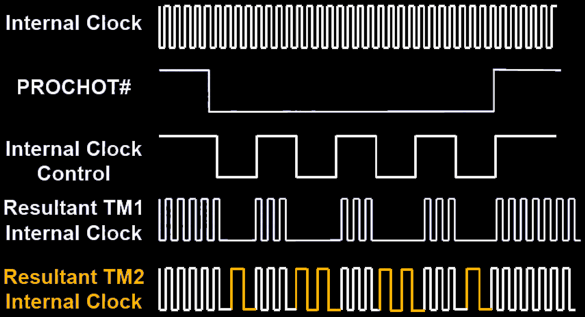A 4.1 GHz Dual Core at $130 - Can it be True?
Risk-free Overclocking, Including Heat Protection
The Pentium D supports version 2 of Intel's Thermal Monitor, a protective mechanism that enables the system to keep running and also prevents damage to the processor itself. Thermal Monitoring has been around since the Pentium 4 (Willamette) was introduced in 2000. If the CPU exceeds a specific temperature threshold, the clock controller for the processor automatically throttles back from time to time. This causes power consumption (and thus also heat output) to diminish quickly, though obviously performance will suffer noticeably.
The reworked Thermal Monitoring 2 is smarter, because the clock controller no longer skips clock cycles, but rather throttles back the processor clock rates. For this purpose, the controller likewise uses the PROCHOT signal, to allow the system to keep running smoothly, albeit at a reduced clock rate. Because the activation of PROCHOT as a protective mechanism through Thermal Monitoring 2 occurs right in the processor, neither BIOS updates nor settings changes are needed. The already described Enhanced Halt Mode C1E takes this one step further, and applies this when the idle process is running in the operating system.

Block diagrams of the workings of Thermal Monitoring 1 and 2.
Because Thermal Monitoring 2 provides a form of "overheating insurance", as it were; it's easier to overclock systems with this capability. Should the system overheat, it also reacts noticeably better than a system protected by Thermal Monitor 1. Thus, the second version of Thermal Monitor offers an additional bonus for overclockers to exploit.
Stay on the Cutting Edge
Join the experts who read Tom's Hardware for the inside track on enthusiast PC tech news — and have for over 25 years. We'll send breaking news and in-depth reviews of CPUs, GPUs, AI, maker hardware and more straight to your inbox.
Current page: Risk-free Overclocking, Including Heat Protection
Prev Page Energy Saving Functions Lack C1E Next Page Ready For The 64 Bit FutureTom's Hardware's dedicated news crew consists of both freelancers and staff with decades of experience reporting on the latest developments in CPUs, GPUs, super computing, Raspberry Pis and more.
-
Tnias I am quite interested in your post regarding the D 805. Considering that it is now available for around $60.00 (03/20/09), it still sounds like a steal. We just upgraded our Adobe CS2 software to the new CS4 Master Suite, which caused the need for a graphics card upgrade. We have an nVidia GeForce GTX 260, but haven't installed it because our computer is a HP Media Center PCm7350n computers each with a 2.8 GHz CPU on a ASUS P5LP-LE mobo. Your article seemed to imply that there is software available that might adjust the clock from inside windows and we are wondering if it can on that mobo or if we will have to get a different mobo. If so, we are wondering what might be our most cost effective but stable options. We are certainly going to need a new power supply for the GTX 260, which requires 525 Watts. We are looking at just putting in PC Power & Cooling’s, Silencer 610 EPS12V power supplyand letting it go at that, but we are also thinking about upgrading the CPU and mobo if necessary.Reply
Of course, we would like to keep the cost down as much as possible.
We have no idea where the best bang for the buck will be. For us a stable system is more important than blazing speed. Thus, the HP's worked fine for what we originally got them for; it’s just that our graphics and video production software are forcing upgrades in speed and power.
The D850 chip sounds incredible and the power supply we already have to get will handle overclocking that chip. It even sounds like that chip will work in the existing mobo if we can find a way to change the clock speed from inside windows instead of from the BIOS. HP BIOS does not allow adjusting the clock speed in the BIOS but can't BIOS just be changed as well; isn't it just an EPROM?
Anyway, even if we opt for changing out the mobo for another case compatible Asus mobo, we still have to answer the question of which board and chip combination will give us the most stable service for the least cost.
Any ideas that might help us plan the most appropriate upgrade and the least cost? -
amnotanoobie TniasAny ideas that might help us plan the most appropriate upgrade and the least cost?Reply
With the price of components that you need to make this run stable, and the amount of electricity that this would use, a cheap Core 2 and motherboard and DDR2 memory would cost you less in the long run.
Example:
Intel Pentium Dual Core E5200
Kingston DDR2 2x2GB 800MHz
Gigabyte G31M-ES2C
This should cost less than $200.
Most Popular


